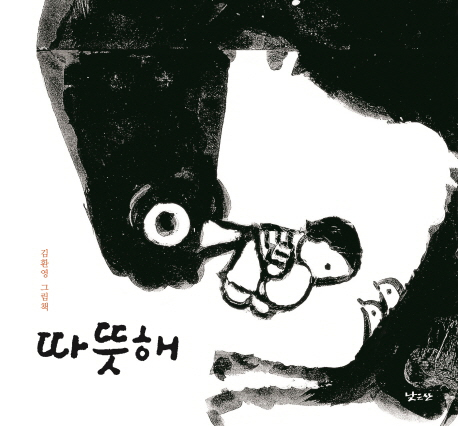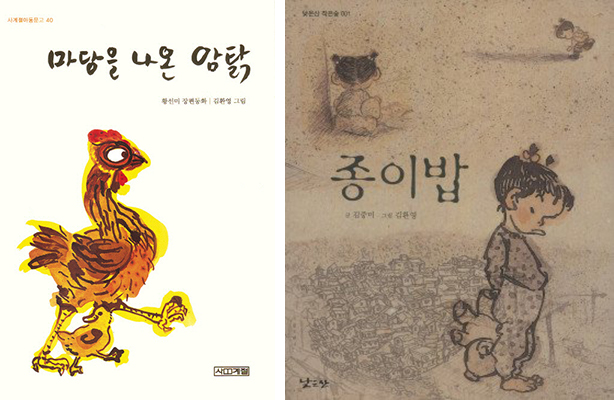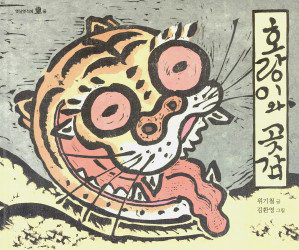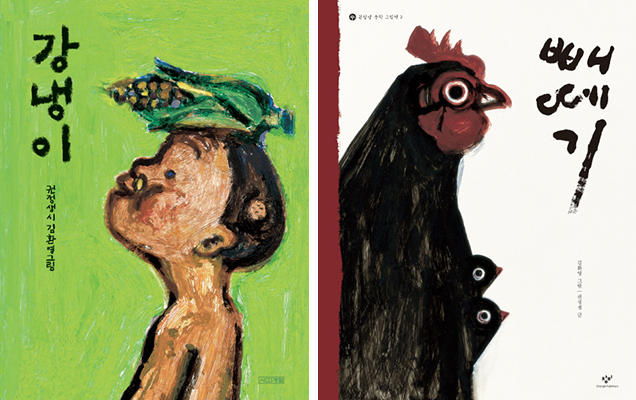|
Illustrator Kim Hwan-Young
2019.07.08
Illustrator Kim Hwan-Young has captured readers' hearts with his beautiful work in children's tales like Paper Rice (naznsan), The Hen Who Dreamed She Could Fly (Sakyejul) and The Children Who Swallowed the Sun (Changbi), as well as picture books including The Butterfly Catching Father (Gilbut Children), Corn (Sakyejul) and Bbaeddaegi (Changbi). His illustrations are known for their powerful brush strokes that can seem crude and rough at times, while his India-ink painting style conveys Korean emotions. Kim often opens up his atelier to readers, which is nestled inside a small countryside village in Boryeong, South Chungcheong Province. After leaving the city for the countryside, Kim created a studio for himself, and he has never stopped working since. In fact, he has been creating more artwork, as the artist has said his work required him to have a sincerity that could only be gained from living outside the city. The books Kim has illustrated have a quaint, countryside beauty to them, and living outside the city has only made Kim's work more plentiful and polished.
Q. Hello. It is wonderful to meet you through our webzine, K-Book Trends. Can you please introduce yourself to our readers?
A. Hello, I am Kim Hwan-Young, currently making picture books in a small city called Boryeong in South Chuncheong Province.
Q. Was there a specific reason you decided to move to the countryside?
A. I think it was the influence of fairy tale books that led me to leave the city. In fairy tale books, oftentimes you find yourself needing to draw scenes from the countryside, but I grew up in Seoul, and there were many aspects I simply wasn't aware of because I lacked that experience. Especially in the case of fairy tales written by Kwon Jung-saeng, there were many things I couldn't express because I hadn't grown up in the countryside. These things all led me here, and I think I am now 50 percent country folk.
It's Warm
Q. Through your existing work like The Hen Who Dreamed She Could Fly, Paper Rice, Bbaeddaegi and Corn as well as your most recent It's Warm, you've already reached so many readers. You've left a mark on readers who enjoy your work with broad, crude brushstrokes and Korean style of illustrating. What is most important to you when you illustrate books?
A. That would be the reality of things. This refers to my current style of living, as well. Many readers refer to The Hen Who Dreamed She Could Fly as my most representative work and this I started illustrating in the city. I completed it in the countryside. I did my best when I was in Seoul, but I realized there were limits. To create paintings of rural scenery, I even resorted to carving my own brushes out of bamboo.
The Hen Who Dreamed She Could Fly, Paper Rice
Q. Your most recent publication It's Warm was written and illustrated by you. What was the message you wished to convey in the book, and what do you think is the most important part of the book?
A. As an illustrator, you receive a story from someone else, and you start painting. But from some 20 years ago, I accepted almost no stories written by someone else because I wanted to write about my life down in the countryside.
Q. While you were working on your latest book, what did you feel was the difference between illustrating for someone else and writing and illustrating at the same time?
A. When you write your own story, there can be difficulties, but eventually, you're dipping into your own experiences. I also contemplated deeply on the message that my writing had. I wrote the story, but I also tried to look at it from a stranger's point of view. I kept asking myself questions about the story, going in and out of the story as the writer and a reader. In this process, I think I went to the far reaches of my consciousness then, like I was reaching for an unconscious state. In the case of It's Warm, the initial sketches for my illustrations were deeply affected by two broad elements, or memories that I have. One would be when I first saw a chicken trapped inside a wire cage at a market in Gapyeong and the other was when I saw a child whose birth name was 'potato'. When recalling memories, one may remember fleeting emotions from their experiences. I continuously tried to confirm whether the message I was telling was accurate, and in that process, you reach an emotional peak, and I tried to stay in that mindset for as long as I could. When you're illustrating someone else's work, this doesn't occur easily, but I think it was possible because it was my story. When looking back on my previous experiences, The Hen Who Dreamed She Could Fly had good results because I felt one with the story. It's somewhat a physical reaction, and I think it happens more often when I write my own stories.
I won't stop reinterpreting It's Warm, which I wrote and illustrated.
Q. Your affection for It's Warm is probably quite substantial because it was the first book where you also wrote the story in addition to illustrating it. Were there any differences from your previous work?
A. In 2010, I published a collection of some 50 nursery rhymes. This was the very first time I had to express something in words and not through visual art. My art had been shown in competitions and exhibitions, but one day I stumbled upon poetry, and I started writing poems. When I created my collection of poems, the biggest hardship I had was working with words. The pressure was also on because these weren't spoken words that disappear once you say them, but written words that remain on record.
Q. When you're selecting stories to illustrate, what are your most important criteria? We'd like to know if you have specific standards unique to yourself.
A. I try to look for sincerity from the story and how polished it is. The biggest element for me, I think, would be sincerity. If you can't agree with the author's view of the world or values, then you can't illustrate their stories. I started illustrating for story-writers 30 years ago, and I've published over 100 books since. Even when I illustrated books to put food in my mouth, I needed to find an understanding of the story content. When that understanding is lacking, it's hard to express stories in art form. Even when you agree with the content and have an understanding, the illustrations might not happen. Personally, I believe I have limitations when it comes to quiet stories. My illustrations go best with stories that are active.
In the past, I tried to hide this strength in my art
Q. Many associate your work with traditional Korean art, saying your illustrations have many overlapping elements. Could you list the pros and cons of that when it comes to exporting your work overseas?
A. I don't intentionally lean on Korean tradition when illustrating stories. I try to stick to drawing what I feel, and the things I've experienced and seen are reflected in my work. I am Korean, and the aspects of my life lived as a Korean person are probably why the Korean psyche can naturally be spotted in my work. It's not like I consciously remind myself how to illustrate in a certain style.
The Tiger and Persimmon
In the case of The Tiger and Persimmon (Kookmin Books), we received a lot of feedback from foreign readers. I think it was more so because the illustrations were made with carved wooden prints. It wasn't a deliberate decision to have the illustrations look like traditional Korean art - the illustrations came about after deep thinking on what they should look like. I actually think one should avoid the term 'Korean' when describing art because traditional art exists elsewhere too, and there are many elements that overlap between cultures. At times I ask myself whether the term 'Orientalism' that is used by the West to describe Asia is all-positive.
Q. Your work was selected to represent Korea at the Biennial of Illustration Bratislava and also included in an artist reference book created by the Korean Board on Books for Young People (KBBY). Like these examples, your work is continuously being introduced to readers outside South KoreA. How do you feel about the opportunities being given to you to reach foreign readers? We're also curious to learn if you have a sense of duty as an artist who is helping Korean children's books become known elsewhere.
A. The history of Korean picture books now spans roughly 30 years. In my case, I have worked as an artist and a poet. I've launched a magazine on nursery rhymes, and I've also worked with various formats like animations or comics. I feel a slight bit of pressure introducing myself to foreign readers as a picture book illustrator because I've dabbled in many other things. The Hen Who Dreamed She Could Fly was released in 30 different countries and for nearly all of the exported publications, the illustrations accompanied the story. It was surprising to me that all of these countries decided to accept the illustrations despite some cultural disparities. Often you will see stories exported, but illustrations rarely get the same treatment when it comes to children's books. It was a relief that there wasn't much pushback against the illustrations when the book was exported to other countries. The chickens, ducks or tree leaves were not detailed nor accurate, but I truly focused on the illustrations, and that is why readers are moved, I believe. When readers in other countries read the book, the book will deliver Korean elements to them, and it is my hope that they will have positive thoughts when they think of KoreA.
Corn, Bbaeddaegi
We are curious to know what the reader response
Q. What do you think are the unique or appealing aspects of your art for readers outside South Korea?
A. That would be the distinctiveness South Korea has in general. Corn and Bbaeddaegi all take place during the Korean War. They're very real stories written for children. I think one of the things all mankind shares is pain. Contemporary Korean history includes the military rule of the Korean peninsula by Japan and the Korean War. The Korean War was a case in which a people were divided into two, aiming guns at each other. The Korean peninsula is still divided today, and that split is the result of that war.
Q. What kind of projects would you like to undertake going forward? Do you have a message you would like to tell children or readers in general with your work? Please tell us about your future plans.
A. I will continue writing and drawing. I would like to open up my life and show the stories I have inside me. It took me a long time to complete something that is wholly mine, but I now want to keep expressing the space I live in and what goes on in my heart. My key themes will be life and peace, but I'm not sure what the format will be. I'm also curious to know what my future path will be like. Even if I tell stories on life and peace, it will eventually be a process in which I search for myself, as I go deep into my future projects. I am planning my second book after It's Warm and this too, carries a world that is whole and warm.
Arranged by KIM Young-Ihm
|
Pre Megazine
-

Jakkajungsin Publishing Co.
VOL.69
2024.04 -

Writer Yun Jung-Eun
VOL.69
2024.04 -

Jumping Books Publishing House
VOL.68
2024.03 -

Writer Kim Hwa-Jin
VOL.68
2024.03 -

Publisher Hyohyung
VOL.67
2024.02 -

Writer Minha
VOL.67
2024.02 -

Almond Publishing
VOL.66
2024.01 -

Writer Kwon Jung-Min
VOL.66
2024.01 -

Hakgojae Publishers
VOL.65
2023.12 -

Writer Kim Hye-Jung
VOL.65
2023.12 -

Eidos Publishing House
VOL.64
2023.11 -

Writer Hwang In-Chan
VOL.64
2023.11 -

Munhakdongne
VOL.63
2023.10 -

Writer Chang Kang-myoung
VOL.63
2023.10 -

Happywell Publishing
VOL.62
2023.09 -

Writer Baik Soulinne
VOL.62
2023.09 -

Dasan Contents Group (Dasan Books)
VOL.61
2023.08 -

Writer Lim Kyoung-Sun
VOL.61
2023.08 -

SpringSunshine Publishing Co.
VOL.60
2023.07 -

Writer Lee Kyung-Hye
VOL.60
2023.07 -

Human Cube
VOL.59
2023.06 -

Doctor Jeong Jae-Seung
VOL.59
2023.06 -

Anonbooks
VOL.58
2023.05 -

Writer Son Bo-Mi
VOL.58
2023.05 -

Namhaebomnal
VOL.57
2023.04 -

Writer Kim Bo-Young
VOL.57
2023.04 -

Hugo Publishing
VOL.56
2023.03 -

Writer Cho Kwang-Hee
VOL.56
2023.03 -

Balgeunmirae Publishing Co.
VOL.55
2023.02 -

Writer Lee Byung-Ryul
VOL.55
2023.02 -

Wisdom House, Inc
VOL.54
2023.01 -

Writer Jeong Jia
VOL.54
2023.01 -

Humanitas
VOL.53
2022.12 -

Writer Kim Yeon-Su
VOL.53
2022.12 -

Songsongbooks
VOL.52
2022.11 -

Writer Eun Hee-Kyung
VOL.52
2022.11 -

Bombom Publishing Co.
VOL.51
2022.10 -

Writer Jiwon Yu
VOL.51
2022.10 -

Hangilsa Publishing Co., Ltd.
VOL.50
2022.09 -

Writer Kim Won-Young
VOL.50
2022.09 -

Moksu Publishing Company
VOL.49
2022.08 -

Writer Yoo Sun-Kyong
VOL.49
2022.08 -

Next Wave
VOL.48
2022.07 -

Writer Park Sang-Young
VOL.48
2022.07 -

A Thousand Hopes
VOL.47
2022.06 -

Writer Bora Chung
VOL.47
2022.06 -

Woongjin ThinkBig
VOL.46
2022.05 -

Dr. Oh Eun-Young
VOL.46
2022.05 -

JECHEOLSO Publishing House
VOL.45
2022.04 -

Writer Jang Ryu-Jin
VOL.45
2022.04 -

Changbi Publishers
VOL.44
2022.03 -

Writer Kim Ho-Yeon
VOL.44
2022.03 -

Mati Books
VOL.43
2022.02 -

Writer Lee Kkoch-Nim
VOL.43
2022.02 -

Picturebook Gongjackso
VOL.42
2022.01 -

Writer Kim Sang-Wook
VOL.42
2022.01 -

Writer So-yeon Park
VOL.42
2022.01 -

Writer Yoo Eun sil
VOL.42
2022.01 -

Kungree Press
VOL.41
2021.12 -

Writer Kim Lily
VOL.41
2021.12 -

Writer Park Yeon-jun
VOL.41
2021.12 -

Writer Yi Hyeon
VOL.41
2021.12 -

A deeper world told through picture books 'Iyagikot Publishing (Story Flower)'
VOL.12
2019.06 -

Author Jeon Min-hee
VOL.12
2019.06 -

Illustrator Kim Hwan-Young
VOL.13
2019.07 -

Travelers sailing through the sea of knowledge - 'Across Publishing Group Inc.'
VOL.13
2019.07 -

Genre Novel Publisher 'Arzak Livres'
VOL.14
2019.08 -

Author Lee Yong-han
VOL.14
2019.08 -

Wookwan Sunim
VOL.15
2019.09 -

East-Asia Publishing
VOL.15
2019.09 -

Author Jo Jung-rae
VOL.16
2019.10 -

EunHaeng NaMu Publishing
VOL.16
2019.10 -

Writer Heo Kyo bum
VOL.40
2021.11 -

Writer Kim So-Young
VOL.40
2021.11 -

Author-illustrator Kim Sang Keun
VOL.40
2021.11 -

ACHIMDAL BOOKS
VOL.40
2021.11 -

Author Kang Gyeong-su
VOL.17
2019.11 -

Moonji Publishing Belongs to the Literary Community
VOL.17
2019.11 -

Author Kim Yun-jeong
VOL.18
2019.12 -

I-Seum
VOL.18
2019.12 -

Kim Cho-Yeop
VOL.19
2020.02 -

Creating a window into the future with books
VOL.19
2020.02 -

Author Serang Chung
VOL.20
2020.03 -

Hey Uhm
VOL.20
2020.03 -

Writer Lim Hong-Tek
VOL.21
2020.04 -

BIR
VOL.21
2020.04 -

Writer Song Mikyoung
VOL.39
2021.10 -

Author-illustrator Kim Dong Su
VOL.39
2021.10 -

Writer Lee Seula
VOL.39
2021.10 -

Tabi Books
VOL.39
2021.10 -

Writer Kim Soo-hyun
VOL.38
2021.09 -

Author-illustrator Lee Myoung Ae
VOL.38
2021.09 -

Writer Hwang Sunmi
VOL.38
2021.09 -

Kidari Publishing Co.
VOL.38
2021.09 -

Writer Sohn Won-Pyung
VOL.22
2020.05 -

Woods of Mind's Books
VOL.22
2020.05 -

Writer Heungeul
VOL.23
2020.06 -

Gloyeon
VOL.23
2020.06 -

Maumsanchaek
VOL.24
2020.07 -

Winners of the 2021 Bologna Ragazzi Award
VOL.37
2021.08 -

Picture book artist Lee Suzy
VOL.37
2021.08 -

Author-illustrator Yi Gee Eun
VOL.37
2021.08 -

Hubble
VOL.37
2021.08 -

Writer Baek Se-Hee
VOL.25
2020.08 -

Bearbooks Inc.
VOL.25
2020.08 -

Author Baek Hee-Na
VOL.26
2020.09 -

Yuksabipyoungsa
VOL.26
2020.09 -

Writer Kang Hwa-Gil
VOL.27
2020.10 -

Kinderland (Bandal)
VOL.27
2020.10 -

Writer Ha wann
VOL.36
2021.07 -

Author-illustrator Myung Soojung
VOL.36
2021.07 -

Writer Jung Yeo-Wool
VOL.36
2021.07 -

Publisher EcoLivres
VOL.36
2021.07 -

Writer Lee Geumi
VOL.28
2020.11 -

Sakyejul
VOL.28
2020.11 -

Writer Kim Keum-Hee
VOL.29
2020.12 -

Geulhangari
VOL.29
2020.12 -

Writer Cheon Seon-Ran
VOL.30
2021.01 -

Hyang Publishing House
VOL.30
2021.01 -

Writer Lee Hee-Young
VOL.31
2021.02 -

Sanzini
VOL.31
2021.02 -

Publisher Prunsoop
VOL.32
2021.03 -

Writer Sim Yun-Kyung
VOL.32
2021.03 -

Hanbit Media
VOL.35
2021.06 -

Hyeonamsa
VOL.33
2021.04 -

Author-illustrator Noh Inkyung
VOL.33
2021.04 -

Writer Cho Won-Jae
VOL.35
2021.06 -

Writer Kim Jung-Mi
VOL.34
2021.05 -

Safehouse Inc.
VOL.34
2021.05















